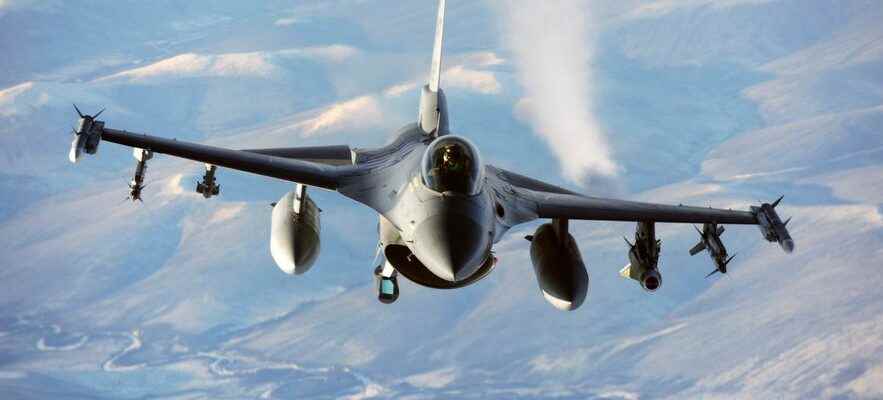The message is written in indelible pen on the pilot’s helmet offered on February 8 by Volodymyr Zelensky to the Speaker of the British House of Commons: “We have freedom, give us wings to protect it”. In London, then in Paris and finally in Brussels, the Ukrainian leader strongly insisted that Westerners finally embark on the delivery of combat aircraft to his country, while Moscow is stepping up its military effort in the East and currently has initiative.
This request responds to a need. To resist the army of Vladimir Putin, that of Ukraine cannot do without a fleet of combat aircraft. However, if Russia has an industry capable of supplying it with new aircraft every month, Ukraine can only count on arms deliveries by its NATO supporters. And as for the tanks, it is no longer a question of obtaining Soviet models that they still have in reserve, but planes that meet NATO standards.
Several types of missions could be entrusted to such equipment, if Westerners give the green light. The first is the most obvious: air defense. It would essentially be for the Ukrainians to ensure control of their skies. “Together with effective target detection systems and communications, this would allow them to repel bombers supporting Russian troops in the Donbass, sometimes firing from far enough away to avoid anti-aircraft defences,” he said. General Jean-Paul Paloméros, former Chief of Staff of the Air Force. But for that, you need runways in the right places, because the Ukrainians don’t have what to do in-flight refueling.”
The Ukrainians could also use Western fighter planes to carry out deep strikes at high altitude, as the Russians do from their territory or that of their Belarusian ally. But we need armaments that lend themselves to it. Reluctant to deliver long-range missiles fired from the ground by MLRS or Himars rocket launchers, it is not certain that the West will give Kiev such a capability via combat aircraft. They could nevertheless obtain a guarantee that they would limit their action to Ukrainian territory.
“The other possibility for Ukrainian pilots is to fly very low, to be detected as late as possible, but there will always be the threat of short-range anti-aircraft systems, says Jean-Paul Paloméros. These missions would make it possible to hit Russian ammunition depots and command centers, not necessarily the trench area, unless the Ukrainians are in big trouble at a particular point. But you need a worthwhile target.”
Pilot training by the British
While no plane delivery has been recorded, a first breach has opened with the promise made by British Prime Minister Rishi Sunak to train Ukrainian fighter pilots “to NATO standards”. It is not, for them, to train on a specific plane. “Even if this does not replace flying, the current simulators are of high quality, they make it possible to become familiar with the specific procedures of the Atlantic Alliance, underlines Jean-Paul Paloméros, who was also the Allied Commander Transformation within Then there are flights on training planes. Within the French Air Force, this can be done with propeller planes whose cockpit simulates that of another plane, like the Pilatus.”
Behind, it will still be necessary to settle the question of the planes likely to be delivered to Ukraine. The British, precisely, will find it difficult to give away anything other than a sample of their Eurofighter Typhoon. These planes “are already in high demand”, with “stocks of spare parts and ammunition in insufficient numbers”, tweeted Justin Bronk, military expert at the British research center RUSI. He also recalled that the “Typhoon (and the American F-16) are not currently suitable for Ukrainian Air Force bases due to their rough surface and risk of debris, while resurfacing them to make the suitable tracks will make them obvious and immediate targets for Russian missile strikes.”
An American F16 fighter aircraft over the Pacific coast on October 16, 2008.
© / afp.com/Jonathan Synder
At least the F-16 would have the advantage of numbers. This American combat aircraft is simply the most widespread of the world’s fleets. Several European countries are parting with it to replace it with the F-35, the Netherlands having openly announced that it is keeping open the option of selling its F-16 fleet to Ukraine. “The F-16 would allow homogeneity of training, use and interoperability for the Ukrainians, underlines General Paloméros. This would make it possible to constitute a squadron of 15 planes. real effects.”
With regard to the French Mirage 2000, called to be all withdrawn from service within ten years to make way for the “all Rafale”, Emmanuel Macron said that he was not excluding “absolutely nothing”. In the entourage of the Chief of Staff of the French Air Force, it is recognized that the 13 Mirage 2000-C recently withdrawn from service “still have a little potential”. But as the French President for his part underlined, there are “deadlines for training, delivery […] incompressible for planes that are not known to Ukrainian pilots”, accustomed to flying on MiGs and Sukhoi from the Soviet era.
Sharp training in the specificities of Western aircraft is all the more essential as they would face a dense network of Russian surface-to-air missile systems. For long range, there are already the S-300s and their successors, the S-400s, and even more numerous and mobile medium and short range systems, such as Buks and Tors. And for low-altitude flights, there are also shots from portable systems. In the skies of their country, the planes and their Ukrainian pilot risk having their wings clipped on each mission.
